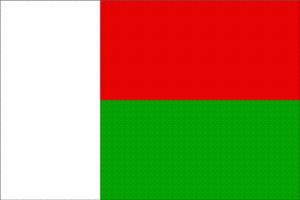Language/Plateau-malagasy/Grammar/Descriptive-Adjectives
Plateau Malagasy has a rich and expressive system of adjectives that are used to describe nouns in detail. In this lesson, you will learn how to use descriptive adjectives in Plateau Malagasy, including their placement in sentences and agreement with nouns.
Don't hesitate to look into these other pages after completing this lesson: Present, Past, and Future Tenses & How to Use Be.
Descriptive Adjectives
Descriptive adjectives are words that describe the characteristics or qualities of a noun. They can express an opinion or fact about the noun and provide more information about it.
In Plateau Malagasy, adjectives usually follow the noun they modify. They also agree in gender and number with the noun. Here are some examples:
| Plateau Malagasy | Pronunciation | English translation |
|---|---|---|
| mpivarotra ratsy | /mpiˈvaru̯tʃ rɑtʃi/ | bad seller |
| ankizy mavo | /ˌanˈkizʲ ˈmavu/ | white children |
| hazo malemy | /ˌhazʷu mɑˈlɛmʲ/ | large tree |
| vary madio | /ˈvarʲ maˈdju/ | good rice |
Note that the adjective changes form depending on whether the noun it modifies is masculine or feminine, and whether it is singular or plural.
In some cases, the adjective may come before the noun for emphasis or clarity. However, this is less common and usually reserved for cases where the adjective is particularly important or unusual. For example:
- Tsy misy raharaha tsy mitovy amin'izao tontolo izao ny fahalavorariana matanjaka. (There is no issue comparable to climate change in this world.)
- Tsy manambady zaza androany izahay fa izay mpitondra ireto zaza ireto. (We are not just babysitting children today, but these future leaders.)
Agreement with Nouns
In Plateau Malagasy, adjectives must agree in gender and number with the noun they modify. If the noun is masculine singular, the adjective must also be masculine singular. The same goes for feminine singular and plural nouns. If the noun is plural, the adjective must also be plural.
Here are some examples:
- Masculine singular noun: mpivarotra ratsy (bad seller)
- Masculine plural noun: mpiara-miasa ratsy (bad workers)
- Feminine singular noun: vehivavy mahafinaritra (clever woman)
- Feminine plural noun: ankizy mahafinaritra (clever children)
Note that some adjectives have irregular forms when used with certain nouns. For example:
- velona (alive) becomes velon'aina when used with a feminine singular noun: vehivavy velon'aina (alive woman).
- fitsarana (beautiful) has different forms for masculine and feminine singular nouns: fitsarana for masculine and mitsaratsara for feminine.
Position in Sentences
In Plateau Malagasy, adjectives usually come after the noun they modify. However, as mentioned earlier, they can sometimes come before the noun for emphasis or clarity.
Here are some examples:
- tsy matoky ny vady ratsy izy (He doesn't trust his bad wife.)
- ny trano lehibe mahafinaritra dia azo antoka fa tamin'ny andron'ny kolonely Imerina no namonoany. (The big and clever house can be assumed to have been built during the colonel's time in Imerina.)
If there are multiple adjectives that modify the same noun, they usually follow a specific order. This order is not strict, and the adjectives can be rearranged to fit the desired emphasis. However, the most common order is as follows:
1. Quantity or number 2. Quality or opinion 3. Size 4. Age 5. Shape 6. Color 7. Origin 8. Material
Here is an example:
- iray biby voalohany tsy misy tombontsoa mahafinaritra (One of the first animals had no remarkable characteristics.)
Examples
Here are some more examples of Plateau Malagasy adjectives in use:
- toerana tsy manan-kibo velona (a place without any living creatures)
- zaza malemy fotsiny (only a few kids)
- maki madio sy mihoatra ny vokatra rehetra (good lemurs and exceeding in all products)
- vary be fanahy toa tsy nifanerasera nampizarazara ny asa rehetra (a lot of humble rice that didn't mix up all the jobs)
Exercises
- Translate the following sentences into Plateau Malagasy:
1. The old man is crossing the road. 2. The big house is on the hill. 3. The yellow bird is singing on the tree. 4. She is a smart student. 5. The small child is playing with the red ball.
- Translate the following sentences into English:
1. tsy ela loatra ny fiainako. 2. zaza mihoatra ny ankohonany ihany no tena mba hanao izay mafy azy. 3. fotsiny ny biby rehetra any atsimondrano amin'izao fotoana izao. 4. ny zaza vaovao no toerana tsara indrindra hahavita ny ady. 5. manomboka mifankahazo an-kiloko ireo mpitondra tsara raha mbola tsy any amin'ny halehiben'ny sitrapony ireo vaovaon-tany.

